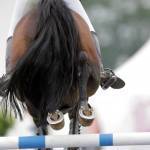Studs in Horseshoes: Helpful or Harmful?

If you sometimes work your horse on grass or muddy ground, you are probably familiar with that unsettling moment when your horse’s feet slip on a turn or the take-off stride right before a jump. Mild slips may just throw you and your horse off balance, but a bad fall or serious injury can sometimes result.
Often, the solution to the traction problem is to add devices, called studs, to the shoe which can punch through the slippery surface to the firmer ground beneath. Screw-in studs come in a range of shapes and sizes and may be selected based on the type of surface and the depth they will need to which they’ll need to penetrate. Set into the horse’s shoes, these stubby metal prongs increase traction on dirt or grass surfaces, giving more stability when the horse turns or stops. However, the use of studs may change how energy from each stride is dissipated, as energy spilled through normal slippage may now be absorbed by the lower limb.
As part of a study conducted at the University of Liverpool and the Royal Veterinary College in London, horses were videotaped as they cantered in a straight line over a grassy surface. During the first videotaping, the horses had front and hind shoes with studs set in a standard arrangement. For the second videotaping, the studs were removed.
Analysis of the movement showed that, without studs, slippage occurred as each foot struck the ground and again as the foot left the ground for the next stride. Studs reduced the distance of slipping in all feet. The reduction was significantly greater in hind than in front feet.
The researchers noted that, while the use of studs did eliminate some slipping, it was not possible to determine whether the benefits of stabilization necessarily outweighed any potential disadvantages.








